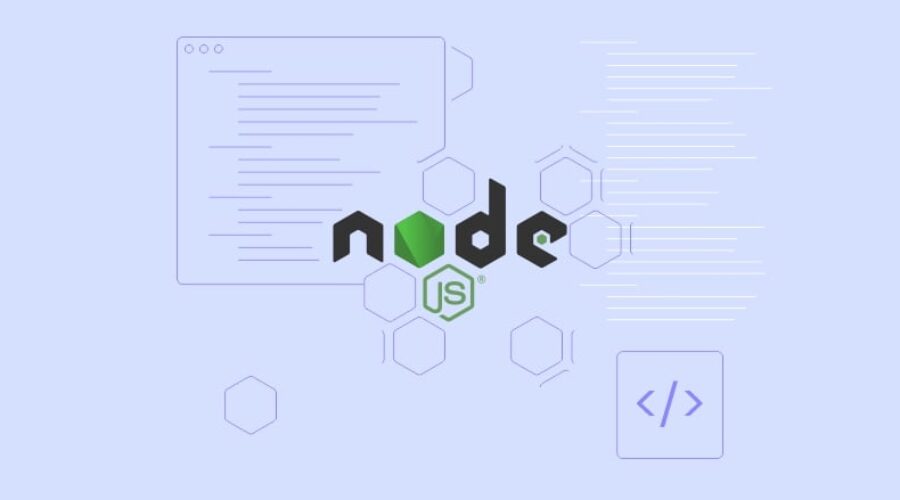What is Node. js? A Complete Guide
While there are several activities that go place in the background or in the backend of our website, the user only really interacts with the frontend of any programme, not the backend. Any programme essentially consists of three components: the front end, with which users interact, the back end server, and the back end database. We can utilise relational or non-relational databases for backend databases, and NodeJS, Java, Python, etc. for backend servers.
What is NodeJS?
Every time a client uses the client side of an application to request something, the request is first sent to the server, where it is processed or calculated in order to validate the client side request. Once all of this validation is complete, a response is then sent to the client side. Basically, this NodeJs JavaScript framework is used for all of these calculations and processing.
NodeJS is essentially utilised as an open-source and cross-platform JavaScript runtime environment for running our web apps outside of the client’s browser. We use this to run the server-side applications. It is used to create I/O-intensive applications like video streaming websites, online chat programmes, and many more. Both newly founded start-ups and numerous established tech behemoth organisations use the NodeJs framework internally.
NodeJs was created in 2009 by a man by the name of Ryan Dahla, and its most recent version is v16.9.0.
An open-source, cross-platform runtime environment and library for JavaScript is called Node.js, and it is used to run web applications outside of the client’s browser. It was created in 2009 by Ryan Dahl, and version 15.14 of it was made available in April of 2021. Node.js is used by developers to build server-side web applications, and because it employs an asynchronous, event-driven approach, it is ideal for data-intensive applications.
After learning more about Node, let’s examine why it is used so frequently in web development.
What Makes Us Use NodeJs?
We prefer utilising NodeJs for the server side of our application for a variety of reasons, some of which are covered here.
NodeJs is constructed using the V8 engine from Google Chrome, which results in an extremely speedy execution time.
Developers can import any of the more than 50,000 bundles in the Node Package Manager at any moment in accordance with their required functionality, saving a significant amount of time.
NodeJs is highly helpful for developing real-time and data-intensive web apps because it does not require waiting for an API to return data. Because of its wholly asynchronous nature, it is completely non-blocking.
Due to greater code synchronisation between the client and server due to sharing the same code base, NodeJs speeds up the loading time for audio and video files.
Since NodeJs is open-source and is merely a JavaScript framework, beginning the development of projects with it is quite simple for developers who are already familiar with JavaScript.
Aspects of NodeJs..
Let’s now talk about some of NodeJs’ features:
The servers built with Node.js are event-driven and asynchronous in nature; they never wait for requests from an API. It advances directly to the following API without waiting for the data from the previous API.
As a result, NodeJS’s whole library of APIs is completely non-blocking. It uses an event-driven method to receive and monitor all of the responses to earlier API requests. As a result, we may conclude that the NodeJs APIs are entirely non-blocking.
Single Threaded Architecture: NodeJs adheres to a single threaded architecture with event looping, which increases NodeJs’ scalability. They create fewer threads than other servers do in order to process requests.
The NodeJS servers respond in a non-blocking or asynchronous way for the event-driven mechanism, which makes NodeJS more scalable. NodeJs can be said to handle more requests when compared to other conventional servers like Apache HTTP servers. NodeJS runs a single threaded programme, which enables it to handle a large number of requests.
Scalable: The majority of businesses today want scalable software. Scalability, one of the most important issues in software development, is addressed by NodeJs.
Using NodeJs, concurrent requests may be managed quite effectively. NodeJs uses a cluster module to manage load balancing across all of the active CPU cores. The most compelling aspect of NodeJs is its ability to partition programmes horizontally, which is primarily made possible by the usage of child processes.
With the use of this feature, separate app versions are offered to the various target markets, and it also enables customization so they may accommodate to the tastes of the users.
Code may be executed quickly because to the V8 JavaScript runtime motor, which is also used by Google Chrome and NodeJs. The hub provides a wrapper for JavaScript, which makes the runtime motor faster and, as a result, speeds up the initial processing of requests inside of NodeJs.
Cross-platform compatibility: NodeJs is compatible with a variety of operating systems, including Windows, UNIX, LINUX, MacOS, and various mobile devices. It can be combined with any suitable package to produce a self-sufficient execution.
JavaScript is used: The fact that NodeJs employs JavaScript is a crucial feature from the viewpoint of an engineer. Since the majority of developers are familiar with JavaScript, picking up NodeJs is much simpler for them.
Fast Data Streaming: It takes a long time to process data that has been transferred to various streams. NodeJs, on the other hand, processes the data quickly and in a very short length of time.
Because NodeJs processes and uploads the files simultaneously, it saves a lot of time. NodeJs consequently boosts the total speed of data and video streaming.
No Buffering: NodeJs applications never buffer data.
Architecture for Node
Now that we know what Node is, let’s explore its architecture. Node.js runs on a single thread, enabling it to manage countless concurrent event loops.
Node.js components..
Now that we have a better knowledge of the server-side platform as a whole, let’s go through each component of Node.js.
A Node.js application can use modules, which work like JavaScript libraries and contain a collection of functions. Use the require() function with the module name in the parenthesis to include a module in a Node.js application.
Numerous Node.js modules offer the fundamental features required for a web application. Several of them are listed in the following table:
Console..
The console is a module that offers a debugging technique that is comparable to the fundamental JavaScript console offered by web browsers. Messages are printed to stderr and stdout.
The foundation of Cluster Node.js is single-threaded programming. A module called Cluster enables multi-threading by generating child processes that simultaneously run on the same server port and share the same server
An application may incorporate a cluster in one of the following ways:
In Node.js, all modules have access to global objects. These items include strings, modules, functions, and more.
Node.js apps encounter four different sorts of failures.
Exceptions are used in Node.js to manage errors. Let’s deal with the error that would result from dividing a number by zero as an example. To prevent the Node.js application from crashing, we must handle this error in order to carry on with the application’s regular operation.
Streaming
Objects called streams allow for continuous reading and writing of data. Four different types of streams exist:
Readable streams are those from which data can be obtained.
Data can be written to these streams since they are writable.
Duplex: These streams can be read from and written to.
Streams that can alter data while it is being read or written are referred to as transforms.
A module called Buffer facilitates the handling of streams that solely include binary data. This technique can be used to construct an empty buffer with the length ’10’:
Domain
Errors that go unhandled are intercepted by the domain module. These mistakes are stopped using two techniques:
- Internal Binding: The run function is where the code for the error emitter is executed.
- External Binding: Using the add method, an error emitter is explicitly added to a domain.



